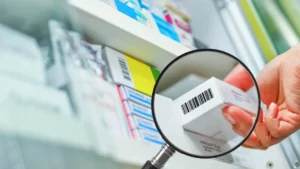The US Food and Drug Administration (FDA) set out four guidances clarifying to the relevant industries how pharmaceutical companies should comply with the DSCSA (Drug Supply Chain Security Act) product traceability requirements.
These requirements were deemed necessary to prevent counterfeit and dangerous products from re-entering the pharmaceutical drug supply chain among other factors, however, consumer safety is considered one of the first and foremost priorities. Indeed, Donald Ashley, director of the Office of Compliance for the FDA’s Center for Drug Evaluation and Research issued this statement: “Ensuring the quality of prescription drugs and safeguarding the integrity of pharmaceutical distribution are crucial roles the FDA plays in protecting the health of the American public. Illegitimate and unsafe products must be kept out of the US drug supply chain.”
The four guidances lay out the importance of identifying trading partners and verification systems for certain prescription drugs and aim to be cost-effective and compliant with government best practices:
- Enhanced drug distribution security
- Identification of suspect products
- Product identifiers
- Suspect and illegitimate product
All four guidances contain the relevant legislation, obligations, processes, and non-binding recommendations that can help you and your business:
Enhanced Drug Distribution Security

This guidance is intended to assist supply chain stakeholders, particularly trading partners, with requirements for enhanced drug distribution security at the package level. The guidance also outlines and provides recommendations for the systemic attributes necessary for enabling secure tracing of the product allowing for the use of verification, interference, and aggregation as necessary.
Trading partners, along with Federal and State authorities, have a role in ensuring the quality of prescription drugs and protecting the integrity of the pharmaceutical distribution supply chain. The DSCSA requirements improve the oversight of trading partners in the supply chain that are involved in the manufacturing, repackaging, wholesale distribution, warehousing or logistical activities, or dispensing of prescription drugs.
Such system attributes, which the FDA regards as fundamental should include:
- the exchange of transaction information and transaction statements in a secure, interoperable, electronic manner;
- transaction information that includes the data elements of the product identifier at the package level for every package included in the transaction;
- systems and processes for verification of product at the package level;
- systems and processes necessary to promptly respond with the relevant transaction information and transaction statement for a product upon request by FDA or other appropriate Federal or State official in the event of a recall or investigation;
- systems and processes necessary to promptly facilitate the gathering of the information necessary to produce the transaction information for each transaction going back to the manufacturer upon request by the FDA or other appropriate Federal or State officials in the event of a recall or to investigate a suspect product or an illegitimate product;
- systems and processes to associate a saleable return product with its applicable transaction information and transaction statement to allow a trading partner to accept the returned product.
This guidance clarifies the enhanced system requirements and sets out the FDA recommendations for the system attributes necessary for enhanced product tracing and enhanced verification, including when the use of aggregation and inference may be appropriate.
Further details on this guidance can be found here.
Identification of Suspect Products

This guidance identifies specific scenarios that could significantly increase the risk of a suspect product entering the pharmaceutical distribution supply chain. The scenarios contained in this guidance are based on FDA agency experience with suspect products within the drug supply chain.
It provides recommendations on how trading partners can identify such products and determine whether a product is a suspect product as soon as possible and it describes when manufacturers should notify the FDA of a high risk that a suspect product is counterfeit or illegitimate.
The guidance also addresses how trading partners should notify the FDA when they determine that a product in their possession or control is an illegitimate product.
“Pharmaceutical trading partners, upon determining that a product in their possession or control is suspect or upon receiving a request for verification from the FDA under product suspicion, must have systems in place that enable them to quarantine the suspect product and promptly conduct an investigation, in coordination with other trading partners, to determine whether a suspect product is illegitimate.”
This guidance further details:
- the identification of some useful specific scenarios that could significantly increase the risk of suspect products entering the pharmaceutical distribution supply chain;
- certain recommendations to assist trading partners in identifying suspect products and making the call about whether a product is suspect as soon as practicable.
For more information on this guidance click here.
Product Identifiers
This guidance details the FDA’s expectations on the format of product identifiers used by pharmaceutical industry trading partners. Product identifiers must use a standardized graphic that includes the product’s standardized numerical identifier; composed of the NDC (National Drug Code) and a unique alphanumeric serial number, lot number, and expiration date, in both human- and machine-readable formats. The machine-readable format must be on a data carrier that conforms to the standards developed by a widely recognized international standards development organization.
The product identifier data is specifically required to be in a “2-dimensional data matrix barcode” for packages and in a “linear or 2-dimensional data matrix barcode” for homogenous cases, which can be verified using “human-readable or machine-readable methods.” Manufacturers are required to “affix or imprint a product identifier to each package of a product intended to be introduced in a transaction into commerce” beginning no later than November 27, 2017.
Repackagers are required to “affix or imprint a product identifier to each package and homogenous case of a product intended to be introduced in a transaction in commerce” beginning no later than November 27, 2018. Therefore, each package of product intended to be introduced in a transaction into commerce must also include the NDC, unique serial number, lot number, and expiration date in both human- and machine-readable formats.
The full guidance including industry Q&A can be read in full here.
Suspect and illegitimate product
This guidance revises the draft guidance for industry Definitions of Suspect Products and Illegitimate Products for Verification Obligations Under the Drug Supply Chain Security Act issued in March 2018. This version clarifies certain points of the March 2018 draft guidance and also adds the FDA’s current understanding of the term stolen (i.e. the prescription drug and its packaging) that has been taken or removed without permission of the owner of the product.
The guidance details definitions in line with the DSCSA for the following terms:
- counterfeit;
- diverted;
- stolen;
- fraudulent transaction;
- unfit for distribution.
More information on this guidance can be found here.
Remember: our expert team specialized in serialization and traceability solutions is ready to answer your questions and guide you through the best decisions for your business. We are just a few clicks away!
{{cta(‘c53b7ee2-ee57-447b-89ef-0e1eddd533c0’)}}




